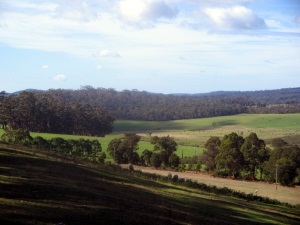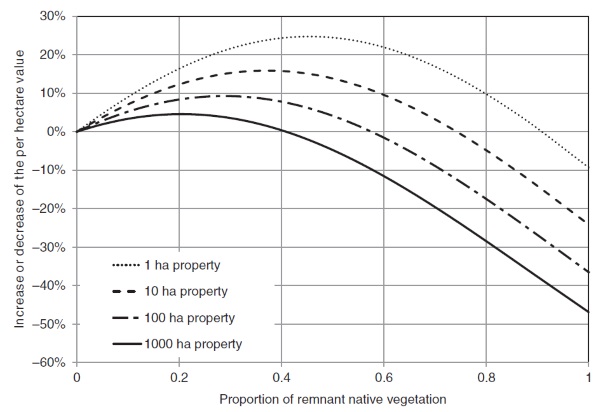287 – Farmers like trees
In many parts of the world, the original establishment of farms required removal of the existing vegetation, creating a different, much less natural, environment. There can be a tendency for some people to view farmers as people who don’t value the environment, but rather seek to destroy it for economic gain. In fact, many farmers have a strong affinity for nature. They have to make a living from their land, but that doesn’t mean they are indifferent to the environment around them.
In a recent study in the Australian state of Victoria (Polyakov et al. 2015), we found that farmers and other rural landholders, on average, pay more for land that includes a proportion of woody native vegetation on it compared with land that is fully cleared. They could, perhaps, make more money from land that is fully cleared, but the price of such land in the market is lower than land that includes some native vegetation – generally native forest or woodland.
Of course, this is only true up to a point. They don’t prefer land that is fully wooded because that leaves no room for agricultural production. Figure 1 shows the pattern we discovered.
Figure 1. Effect of the proportion of native woody vegetation on land value by property size
As the proportion of farm area devoted to woody native vegetation increases above zero, the average value of farm land increases. Eventually it reaches a maximum value at some level, beyond which futher increases in native vegetation reduce land value. Beyond a certain proportion of woody native vegetation, we reach a point where the land value is lower than the value with no trees at all.
While the general pattern is the same for all farm sizes, the numbers are quite different. For a small 1-hectare property, land value is highest when it includes about 45% woody native vegetation. Such land is about 25% more valuable than fully cleared land. These high values reflect that the owners of such small properties are probably there mainly for lifestyle reasons, not to make money from farming (Pannell and Wilkinson, 2009).
At the other end of the spectrum, large landholders (e.g. 1000 hectares) are probably mainly conducting commercial agriculture. However, they still like trees. For them, land value is highest when it includes about 20% native vegetation. At this level, land value is about 4% higher than for fully cleared land. For these farmers, land with anything up to 40% tree cover is worth more than fully cleared land.
For other property sizes, the results fall in between these cases but follow the same pattern.
Interestingly, if we look at the absolute area of native vegetation instead of its proportion, the optimal area is larger on larger farms. For example, the optimal area of native vegetation is 0.45 ha on a 1-ha property, 4 ha on a 10-ha property, 30 ha on a 100-ha property and 200 ha on a 1000-ha property.
 You might be surprised that the optimal area of woody native vegetation for large commercial farmers is so high. I was. We think that there are several contributing factors: the high amenity value of woody native vegetation in this region, its contribution to agricultural production particularly through provision of shelter for livestock, and the presence of areas of low-fertility land on many farms meaning that there is little to gain from clearing it. In some cases it may be that farmers are anticipating breaking the land up into small parcels and selling them to lifestylers who value trees highly.
You might be surprised that the optimal area of woody native vegetation for large commercial farmers is so high. I was. We think that there are several contributing factors: the high amenity value of woody native vegetation in this region, its contribution to agricultural production particularly through provision of shelter for livestock, and the presence of areas of low-fertility land on many farms meaning that there is little to gain from clearing it. In some cases it may be that farmers are anticipating breaking the land up into small parcels and selling them to lifestylers who value trees highly.
These results are based on statistical analysis of 7,200 property sales in the region since 1992. Of course, not all farmers with the same farm size have the same assessment of the benefits of native vegetation. However, even those who don’t think it is valuable need to be prepared to pay extra for partly wooded land, or else they will be outbid by other farmers who do see value in trees.
The current extent of native woody vegetation in the region is lower than the extent that would maximize its amenity value to many landowners. In other words, the welfare of many people living in this area could potentially be increased by restoring native vegetation on cleared lands. Of course, whether this is worth doing also depends on the costs of restoration.
There is some public investment in vegetation restoration in the region. Because there is high heterogeneity in the private benefits of native vegetation, there is scope for targeting of this investment. Landowners with high private benefits from re-vegetation would be willing to participate at relatively low public cost.
I did an interview with ABC Radio about this post on 27 November 2015. Listen to it here.
Here is a related video from my free online course, Agriculture, Economics and Nature. It’s an interview with farmer Mike McFarlane about his investments in environmental improvement on his farm, and his support for other nearby farmers to do likewise.
The course is available on Coursera at https://www.coursera.org/learn/agriculture-economics-nature.
Further reading
Pannell, D.J. and Wilkinson, R. (2009). Policy mechanism choice for environmental management by non-commercial “lifestyle” rural landholders. Ecological Economics 68, 2679-2687. Journal web page ♦ Ideas page
Pannell, D.J., Marshall, G.R., Barr, N., Curtis, A., Vanclay, F. and Wilkinson, R. (2006). Understanding and promoting adoption of conservation practices by rural landholders. Australian Journal of Experimental Agriculture 46(11): 1407-1424. Journal web site
Polyakov, M., Pannell, D.J., Pandit, R., Tapsuwan, S. and Park, G. (2015). Capitalized amenity value of native vegetation in a multifunctional rural landscape, American Journal of Agricultural Economics 97(1):299–314. Journal web page ♦ Ideas page

Was the value premium determined within locations/regions? Was it corrected for “base” pasture production?
I would say a reasonable number of farms in the sales database would be dairy farms, and earnings potential (and hence land value) would be closely linked to pasture production (backed by data).
Ranking regions for descending pasture production, I would say Gippsland, Southwest, Northern Vic (backed by data).
If I ranked them, off the top of my head, for expected area of trees on an average farm, they would be in the same order. This multicollinearity could be an issue if not handled appropriately.
Hi Mark,
Thank you for your interest to this study and your questions.
First of all, I would like to clarify that the study area is in North Central Victoria (NC CMA). For this reason we cannot compare Victoria regions you mentioned.
Within the study area, we control for observable attributes (proximity to population centres, rivers, slope, etc) as well as for unobservable location specific attributes. The premiums are calculated relatively to similar property of same size in same location, but without any native vegetation. I am not so sure what correction for “base” pasture production means.
In our dataset, about 2.5% properties (about 5% area) are classified as dairy farms, they are located mostly in north-eastern part in irrigates zone along Murray river. About 30% properties (60% area) are classified as “Mixed farming and grazing without structural improvements”.
Finally, in this study we control for both spatial autocorrelation and multicollinearity.
The post is really interesting and highlighting the facts about how farmers make a choice in selecting land which they feel that it would be profitable to them.
The farmers choose land which has more vegetation on it rather than the bare land which after when goes to the market the price of bare land is less then the land which has some vegetation. So now the farmers are liking the trees very much because even that choice is very profitable for them in the future. This post actually gives a lot of information about importance of vegetation as it adds beauty to the environment and also gives profit to the farmers. And this is a fact I think that if farmers are happy we all our happy because they are the one who are giving us food.